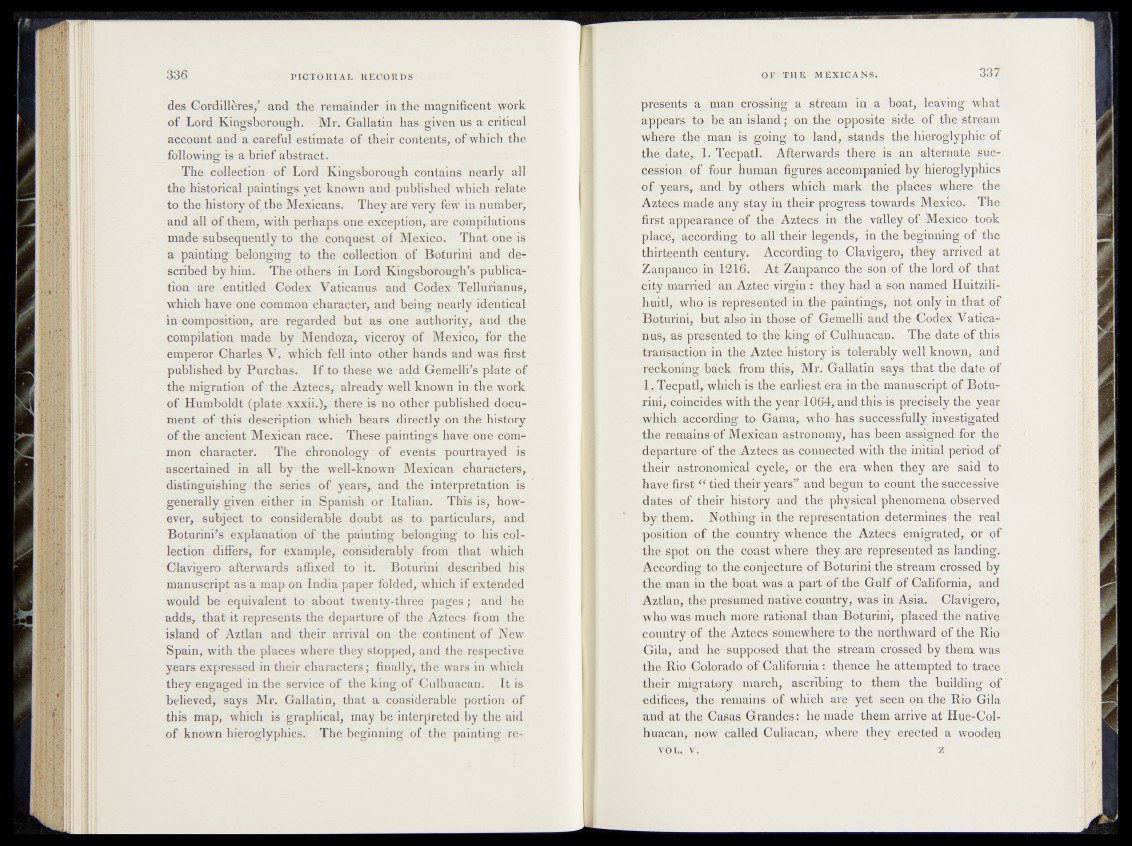
des Cordillères/ and the remainder in .the magnificent, work
of Lord Kingsborough. Mr. Gallatin has given us a critical
account and a careful estimate of their contents, of which the
following is a brief abstract.
The collection of Lord Kingsborough contains nearly all
the historical paintings yet known and published which relate
to the history of the Mexicans. They are very few in number,
and all of them, with perhaps one exception, are compilations
made subsequently to the conquest of Mexico. That one-is
a painting belonging to the collection of Boturini and described
by him. The others in Lord Kingsborough’s publication
are entitled Codex. Vaticanus and Codex Tellurianus,
which have one common character, and being nearly identical
in composition, are regarded but as one authority, and i the
compilation made by Mendoza, viceroy of Mexico, for the
emperor Charles V. which fell into other hands and was first
published by Purchas. If to these we add Gemelli’s'platê of
the migration of the Aztecs, already well known in the work
of Humboldt (plate xxxii.), there is no other published docu^
ment of this description which bears directly on the history
of the ancient Mexican race. These paintings have eneeortL-
mon character. The chronology of events poürtrayed is
ascertained in all by the well-known* Mexican characters,
distinguishing the series of years,, and. the interpretation is
generally given either in Spanish or Italian. This is, however,
subject to considerable doubt as to particulars, and
Boturini’s explanation of the painting belonging to his collection
differs, for example, considerably from that which
Clavigero afterwards affixed to it. Boturini described his
manuscript as a map on India paper folded, which if extended
would be equivalent to about twenty-three pages; and he
adds, that it represents the departure of the Aztecs from the
island of Aztlan and their arrival on the continent of New
Spain, with the places where they stopped, and the respective
years expressed in their characters; finally, the wars in which
they engaged in the service of the king of Culhuacan. It is
believed, says Mr. Gallatin, that a considerable portion of
this map, which is graphical, may be interpreted by the aid
of known hieroglyphics.. The beginning of the painting re-*
presents a man crossing a stream in a boat, leaving what
appears to be an island-;, on the opposite side of the stream
where the man is going to land, stands the hieroglyphic of
the date, 1. Tecpatl. Afterwards.^there,-.is an alternate succession
of four human figures.,ao|!pmpanied by hieroglyphics
of years, and by others which,.mark -the places;.where the
Aztecs made any stay in their progress towards Mexico. The-
first, appearance ^ the r Aztecs in „the. valley of Mexico took
place, „ according* to, all theirdegends,. in the beginning of the
thirteenth century. According. to^Qlavigero, they arrived at
Zanpanco-in 12f6. At Zanpanco the son =.of the ldrd of that
city married an Aztec< virgin-:, they had a-sonmamèd Hpézili-
huiti, who'4s. represented in the paintings, .not only in that of
Bcèurini, but also in those-p^Gemelli and the Codex Yatica*
nus, as presented to the king of*Cnlhuicaias. The date e f this'
transaction in the Aztec history is, tolerably -well known,; and
reckoning hack from this, Mr. Gallatin says that the daté of
I... Tecpatl, which is the earliest era in the manuscript of Botffr
riq|> coincides with the yean 1064, andthis-is .prepisely-dhe year
which according to Gama, ; wh|tohas successfully investigated
the remains of Mexican astronomy, has been assigned for the
departure of the Aztecs as connected with the initial periodmf
their astronomical Cycles or the era- when they are said to
have .first-^ tied their years’* and begun to count the spccessivse
d ates of their history and the physical phenomena .observed
by,them. Nothing in the representation determines the real
position of the country whence the Aztecs emigrated, or of
the spot on the coast where they are represented as landings
According to the conjecture of Boturini the stream crossed by
the mpn in the boat was a part of the Gulf of California, and
Aztlan, the presumed native country, was in Asia. ^ Clavigero;
who was much more rational than Boturini, placed the native
country of the Aztecs somewhere to the northward of the Rio
Gila, and he supposed that the stream crossed by them was
the Rio Colorado of California : thence he attempted to trace
their migratory march, ascribingr to them the building of
edifices, the remains of which are; ye#‘-seen on the Rio Gila
and at the Casas Grand els he made them arrive at Hue-Col*
huacan, now called Culiacan, where they erected a wooden